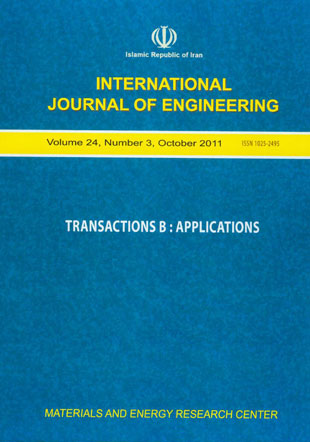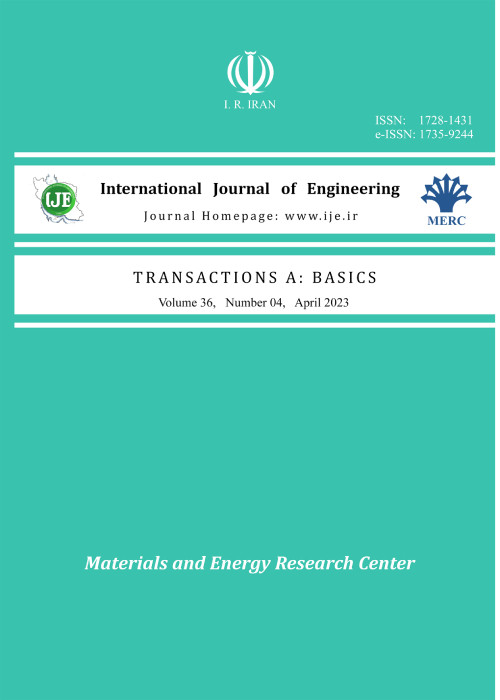فهرست مطالب

International Journal of Engineering
Volume:24 Issue: 3, Oct 2011
- Transactions : B : Application
- تاریخ انتشار: 1390/10/06
- تعداد عناوین: 9
-
-
Page 197Central composite orthogonal design was applied to quantify relations of xylanase production, loss of dry matter and change of pH with four critical variables during solid state fermentation of a mixture of wheat bran and wheat straw on which Aspergillus niger CCUG 33991 was cultivated. The studied variables included the percentage of wheat straw, wheat bran, temperature, moisture content, and fermentation time.The second-order quadratic model predicted the xylanase activity at a suitable set of conditions namely 29°C, 55% moisture content, and 50 hours of fermentation to be 1465 U/g of fermented dry matter which differed less than 6% from measured value at this set of conditions. Furthermore, the obtained models predicted dry matter loss and pH with less than 17% error for the same conditions. The results were used for xylanaseproduction in an intermittently mixed forcedly aerated pilot. Applicability of models for prediction of pilot scale SSF performance was investigated. The results showed considerable deviations of measured trends from model predicted ones. Presence of mixing, temperature and moisture shocks and better oxygen supply are of possible reasons of deviations.
-
Page 209In recent years, deadly earthquakes in seismic areas have made researchers andspecialists to pay special attention to liquefaction phenomenon. Excess pore water pressure in loose sediments may cause phenomena such as boiling, shearing strength and dynamic stiffness reduction and lateral movements with associateddifficulties. So farmany remedial methods such as soil replacement with proper materials, in situ compaction of the soil, soil improvement using in situ grouting, and column drains have been designed and used to overcome liquefaction phenomenon. For areas with liquefaction potentials and high depths, soil replacement method is generally impossible, and vertical drain method which is both economical and easy in execution can be used as an alternative way. In this article, three series of 1-g shaking table laboratory tests were carried out, andvertical column gravel drains were modeled. In the models, various importing acceleration with variation in column gravel drains distances were studied. For modeling, Anzali shore sand situated in the north of Iran was used. Results showed that the behavior of gravel column drains varies with variation in imported seismic acceleration, and the output of this method for reduction of liquefaction potential is affected considerably. The results also showed that the conventional design method criteria to determine distances between the drain columns are very conservative.
-
Analysis of a Beam under Moving LoadsPage 227
-
Page 237In this paper a novel common mode separation technique for implementing fully differential current buffers is introduced. Using the proposed method two high CMRR (Common Mode Rejection Ratio) and high PSRR (Power Supply Rejection Ratio) fully differential current buffers in BIPOLAR and CMOS technologies are implemented. Simulation results by HSPICE using 0.18μm TSMC process for CMOS based structures in 1.4V supply voltage and transistor models NUHFARRY and PUHFARRY for BJT based one in 1.6V supply voltage show CMRR of 32.9dB and 33.1dB for CMOS based and BJT based fully differential current buffers respectively. The proposed fully differential current buffers show PSRR- of 114dB and 116dB in CMOS and BIPOLAR technologies respectively while their PSRR+ are 100dB and 109dB respectively. The proposed common mode separation technique can also be arranged in partial positive feedback configuration to provide high current gain too. Simulation results of this configuration in CMOS technology, show current gain and CMRR of 20.86dB and 53.91dB respectively. The proposed method tends to be a fundamental technique in current mode signal processing capable to be much further improved and utilized. Favorably, corner case simulation results of the proposed structures prove their robustness against technology process.
-
Page 251This paper presents a novel bi-objective manpower scheduling problem that minimizesthe penalty incurred by the employees’ assignment at lower skill levels than their real skills and maximizes the employees’ utility by assigning them at desired skill levels in some shifts/days.Employees are classified in two specialist groups and three skill levels in each specialization. In addition, the presented model executes some essential work regulations. This paper also proposes a solution procedure based on the utility of objective values. Applying this procedure, an effective point is obtained for the given problem. This is the point where both objective functions have the highest utility simultaneously.
-
Page 263In this work, the effect of carbon dioxide partial pressure on the calcination kinetics ofhigh purity zinc carbonate hydroxide has been studied. Non-isothermal analysis has been performed on samples at different CO2 partial pressures by TGA and DTA. It has been found that the calcination behaviour of this material corresponds to the shrinking core model and the reaction mechanism is phase boundary controlled. The calcination reaction of zinc carbonate hydroxide starts at 240 oC.Increasing the carbon dioxide partial pressure can result in an increase in the reaction starttemperature of up to 30˚C. The activation energy for the reaction is calculated as 180 ± 5 kJ/mol at significant CO2 partial pressures.
-
Page 269This research describes unsteady two-dimensional reacting flow around a circular cylinder. The numerical solution combines random vortex method for incompressible wodimensional viscous fluid flow with a Simple Line Interface Calculation (SLIC) algorithm for propagation of flame interface. To simplify the governing equations, two fundamental assumptions namely Low Mach Number and Thin Flame Thickness are used. Numerical and graphical representation of vorticity field, velocity variation on the wake axis, the effect of combustion on stream line pattern and location of vortex element at Reynolds numbers of 3000 and 9500 are discussed. The numerical results for the non-reacting flows fall within the range of the experimental measurements while the results of the reacting case are qualitatively following the physics
-
Page 279The buoyancy-driven fluid flow and heat transfer in a square cavity with partially active side walls filled with Cu-water nanofluid is investigated numerically. The active parts of the left and the right side-walls of the cavity are maintained at temperatures Th and Tc, respectively, with Th>Tc. The enclosure’s top and bottom walls, as well as, the inactive parts of its side walls are kept insulated. The governing equations are discretized using the finite volume method and the hybrid scheme. Using the developed code, a parametric study is undertaken and the effects of the Rayleigh number, the locations of the active parts of the side walls, the volume fraction of nanoparticles, and inclination angle of cavity on the fluid flow and heat transfer inside the cavity are investigated. It is observed from the results that the average Nusselt number increases with increasing both the Rayleigh number and the volume fraction of the nanoparticles. Moreover, the maximum average Nusselt number occurs for the middle-middle location of the thermally active parts.
-
Page 293Simultaneous effects of slip and heat transfer on peristaltic transport of an incompressibleelectrically conducting viscous fluid in an asymmetric channel is studied under the assumptions of long wavelength and low Reynolds number. The asymmetry is produced by choosing the peristaltic wave train on the walls to have different amplitudes and phases. Exact solutions for stream function, velocity field, temperature profile and pressure gradient are obtained. The effects of different parameters entering into the problem on pressure rise are discussed numerically and explained graphically. Also, pumping and trapping phenomena are discussed by numerical integration.


